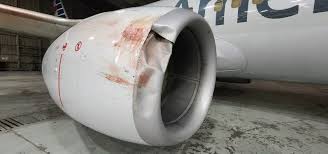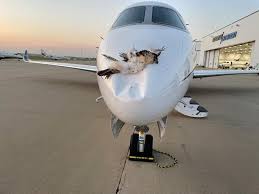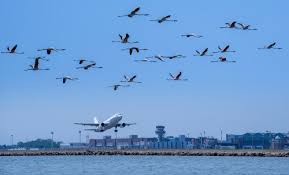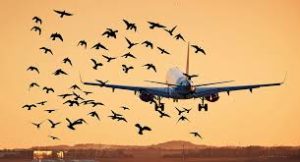- Experts To Discuss Infrastructural Growth At Transport Summit
- Ex-Virgin Nigeria Staff, Reminisce, Unite To Chart Strategic Aviation Future
- IATA: Europe, largest int’l market for passenger flow from Nigeria, aviation contributes $2.5b to nation's GDP
- States stuck in rat race for own airlines
- Air Peace takes delivery of second regional Embraer190 aircraft
Bird Strikes: The Dangers, Consequences

The predicaments of airlines are mounting and further exacerbated by the high recurrence of bird strikes, writes WOLE SHADARE
Challenges
Bird strikes are one of the challenges facing airlines, especially during the rainy seasons. In Nigeria, bird strikes occur at all times. Although the amount of money spent by airlines to repair their aeroplanes is unknown, experts put the figure at over N20 billion annually.
A bird strike—sometimes called bird ingestion, birds hit, or bird aircraft strike hazard —is a collision between an airborne animal and a moving vehicle, usually an aircraft. The term is also used for bird deaths resulting from collisions with structures such as power lines, towers, and wind turbines.
NCAA worried

The menace of bird strikes and the effect on aircraft and, by extension, airline operations caused the Nigeria Civil Aviation Authority (NCAA) to raise concerns about the situation.
The Murtala Muhammed International Airport in Lagos, Port Harcourt International Airport, Sam Mbakwe Cargo Airport in Owerri, and Akwa Ibom Airport are the top four airports worst hit by bird strikes.
Bird strike occurs when birds collide with aircraft in the air and cause damages to the aircraft, as the aircraft engines tend to suck the birds in.
In fact, MMIA Lagos recorded four bird strikes on Runway 18R in a single day in 2025, prompting the NCAA Director-General, Captain Chris Najomo, to declare bird strike prevention a high-priority task.
The NCAA is now taking a multi-faceted approach to tackle this challenge, guided by the International Civil Aviation Organization’s (ICAO), framework for safety oversight.
The authority has sufficient powers to create enforceable aviation regulations and has updated the Nigerian Civil Aviation Regulations to compel airports to maintain Wildlife Hazard Management Plans.
NCAA inspectors have undergone intensive training on wildlife hazard management, with some attending advanced training at Missouri University, USA.
The NCAA has published advisory circulars guiding aerodrome operators on complying with wildlife and bird strike regulations and is reviewing and approving Wildlife Hazard Management Plans for airports.
Regular surveillance activities are being conducted to monitor bird strike incidents and ensure compliance with safety regulations.
The agency has identified poor waste management and unchecked habitat growth around airports as contributing factors to bird strikes.
To address this, the authority is working with airports to improve waste management and habitat control.
Controlled plan
Research collaboration with academic institutions is also being encouraged to identify bird types, habitats, and migratory patterns and create tailored wildlife management plans.
With these measures in place, the NCAA expects measurable reductions in bird strike reports within the next year.
By prioritising bird strike prevention and safety oversight, the authority aims to minimise the risks associated with bird strikes and ensure safer skies for Nigerian air travellers.
Lamentation
Aside NCAA that is worried over the menace of bird strikes, airline operators lamented they have spent a lot of money repairing the damages caused by bird strike, adding that they are still spending because the challenge persists.
They are worried that bird strike has continued to disrupt flights, cause flight delays and sometimes flight cancellations.

Although, bird strike is synonymous with flight operations in Nigeria, the incidents of past weeks have brought the matter to the fore as airlines have their aircraft grounded and a situation that has worsened flight delays and cancellations as the airlines are faced with acute airplane shortage.
Threat to safety
Bird strikes are a significant threat to flight safety, and have caused a number of accidents with human casualties. There are over 14,000 bird strikes annually in the US alone.
However, the number of major accidents involving civil aircraft is quite low and it has been estimated that there is only about one accident resulting in human death in one billion flying hours.
It was discovered that the aircraft engine was hit by a bird during take-off, affecting some of the blades of the aircraft engine, forcing the captain of the aircraft to make air-return, a standard practice in aviation to forestall accident.
Investigation shows that bird strike incidents usually affect the engines of aircraft, which costs about $1 million to replace, depending on the type and capacity of the aircraft involved in the incident. This is apart from the cost of shipping the engine into the country.
There are said to be at least 10 bird strike incidents, affecting Nigerian carriers yearly in the aviation industry. Virtually all models of air planes including the classics and NextGen operating in the country had been affected by bird strikes.
Further investigation indicated that in the last 22 months, there have been at least 30 bird strike incidents in the industry; 19 on take-off and another 18 on landing, and half of these incidents took place at the Murtala Mohammed Airport, (MMA), Lagos. There are some others that went unreported.
Although no accident has been recorded in Nigeria as a result of bird strike, not less than 210 people have been killed worldwide due to bird-strikes with aircraft since 1988.
The worst bird strike in aviation history occurred in 1960 when an Eastern Airlines propeller driven Lockheed L-188 Electra crashed into the sea while attempting to take off from Logan Airport.
Sixty-two people tragically lost their lives, with only 10 people surviving, after a flock of up to 20,000 starlings suddenly flew into the path of the aircraft, and hundreds of the birds were ingested into the engines.
Consequently, two of the four engines lost power, a third flamed-out resulting in a quick crash.

Counting the costs
Bird-strikes to aircraft result in some $610 million in damage a year globally. Five jet-airliners have had major accidents involving bird-strikes since 1975. Experts estimate that only about 20 percent of all bird strikes are reported.
On September 27, 2017, an Air Asia Flight from Medan, Indonesia to Penang was forced to return to Medan after a bird was sucked into one of its engines. The airliner was carrying 150 passengers.
There were a couple more such incidents reported in Malaysia in 2016 and 2017. On January 15, 2009, a US Airways jet hit a flock of geese shortly after it took off from LaGuardia Airport in New York and was forced to land in the Hudson River.
With increased air traffic, and rising bird-populations, such a threat is becoming more serious. In Civil Aviation alone till 1974, 130 deaths had been reported worldwide to the International Civil Aviation Organisation (ICAO).
Due to the voluntary nature of civil aviation bird–strike reporting, a great deal of under reporting happens, occurs, especially for minor bird strikes.
Conservative estimates suggest that more routine damage and delays following bird-strikes cost the industry and its insurers $1.2-1.5 billion per year.
Experts’ views
Speaking on the issue in an interview with our correspondent, a pilot with one of the leading airlines, who preferred anonymity, said that Nigerian airlines lose billions of naira to bird strike incidents annually.
The Managing Director and CEO of Aero Contractors, Captain Ado Sanusi told Aviation Metric that the incidents can be minimized by concerned authorities in the Nigerian aviation airspace.
Last line

No attempt has ever been made to avert this hazard in the country. The approach to the menace has to be forensic to know the kinds of birds that are coming around. To control the assault on aircraft, the government must identify species of birds that create problems for airlines, and those things that attract birds to the airport.
Google+

